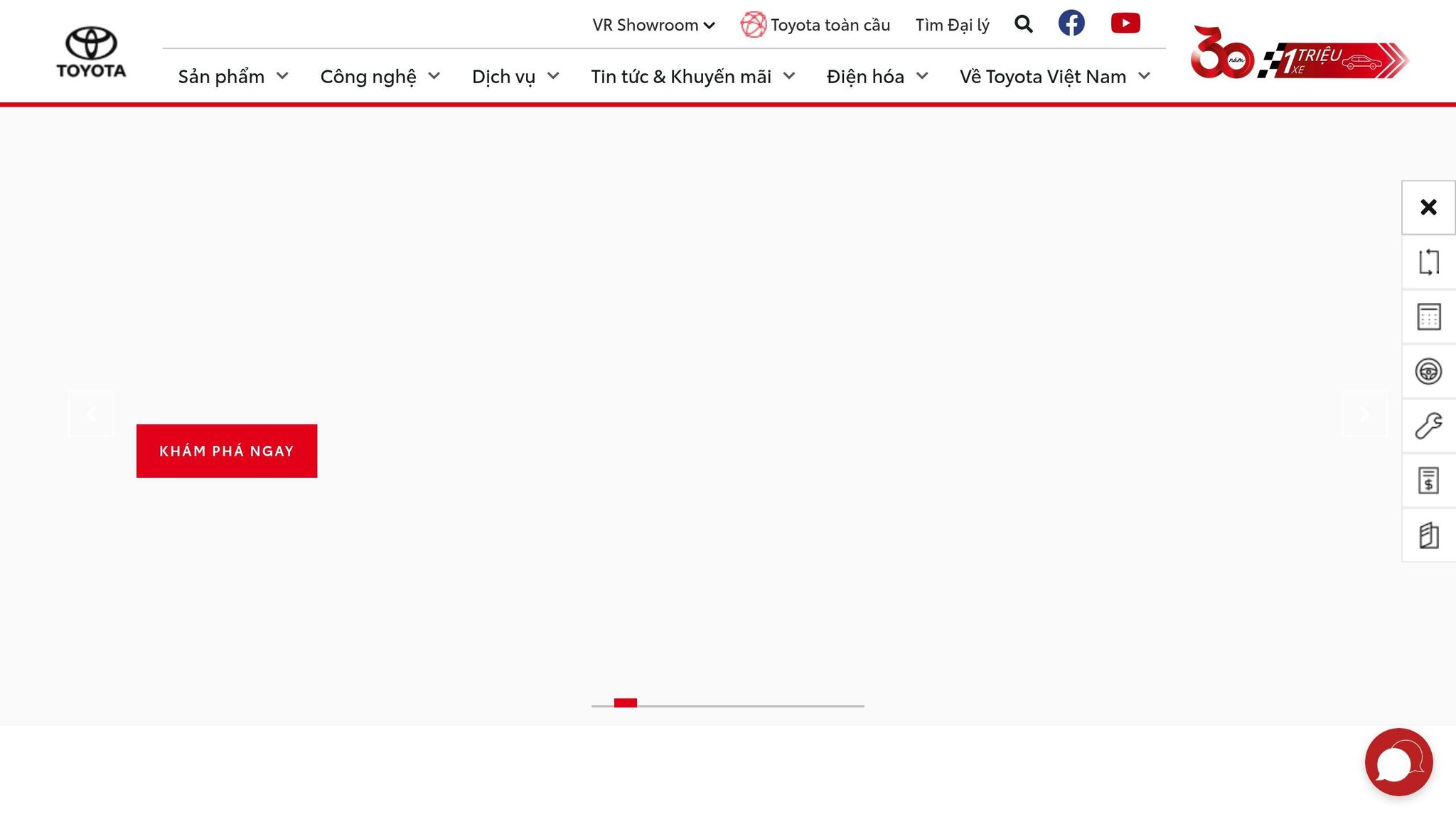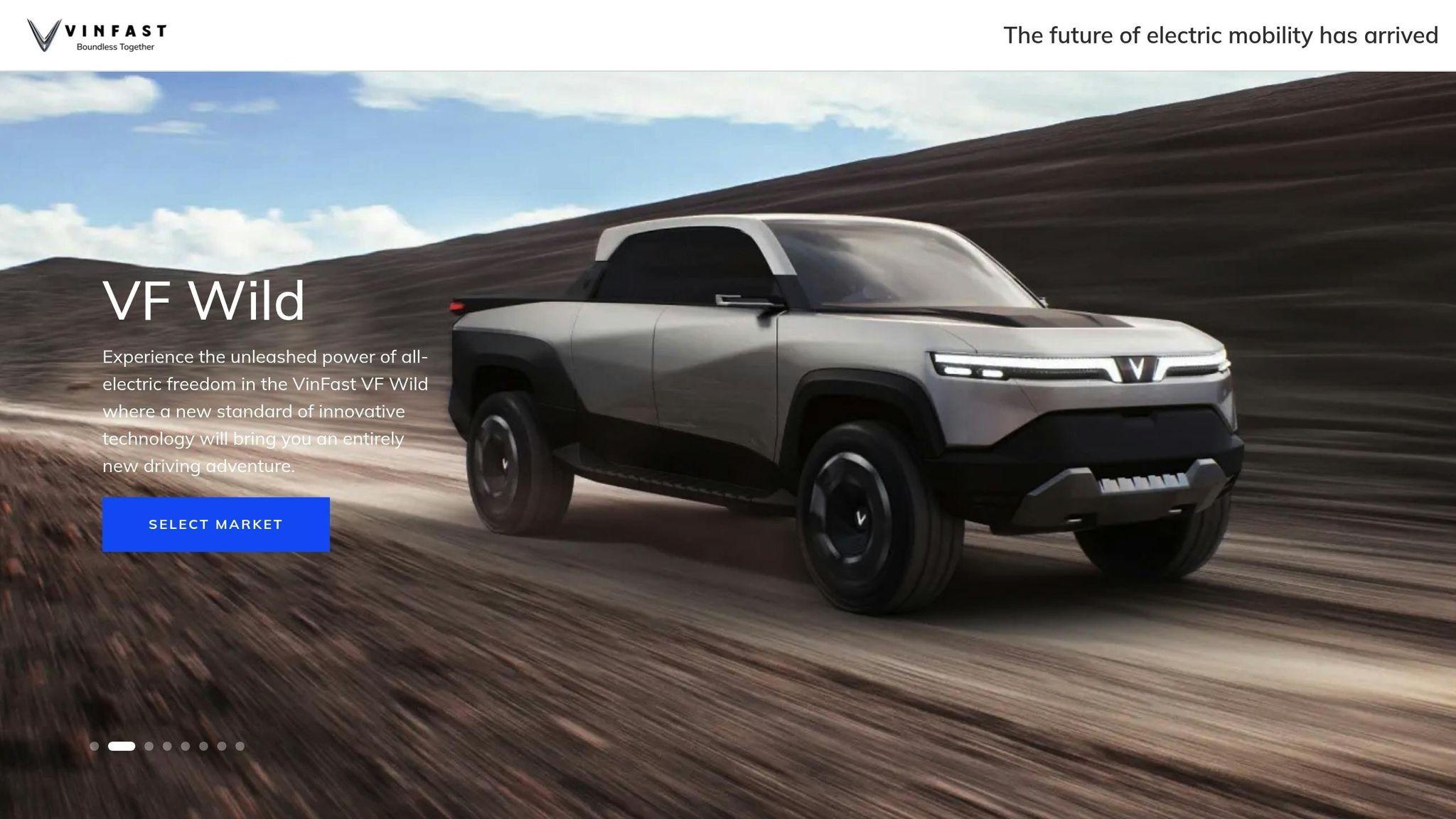Vietnam’s car market is booming in 2025. Sales surged 38.6% by May compared to last year, driven by urbanization, a growing middle class, and interest in electric vehicles (EVs). Yet, car ownership remains low – just 1 in 43 people own a car, showing room for growth.
Key Highlights:
- Electric Vehicles Lead: EVs now make up 20% of new sales, with VinFast dominating at 25.7% market share.
- Competitive Pricing: New Chinese brands and tax cuts on imports have increased options and affordability.
- Popular Models: Toyota Vios (₫458–545 million), VinFast VF 3 (₫235–315 million), and BYD Sealion 6 (₫799+ million) are standout choices.
- Tax Incentives: EVs enjoy registration fee exemptions until 2027, while import duties on luxury cars dropped by up to 7%.
With a projected 12% market growth this year, now is a great time to explore fuel-efficient options, from hybrids to EVs. Whether you’re upgrading or buying your first car, understanding pricing trends and government incentives can help you make smarter decisions.
✅Giá Xe Toyota Vios 2025 Còn 423 Triệu Giữa Tháng 7 | Giảm hẳn 100% Thuế Trước Bạ | Giá Xe Việt

Car Price Breakdown by Brand
Understanding the pricing landscape across various car brands can help you make better decisions in Vietnam’s competitive automotive market. Below is a detailed look at the expected prices for popular models in 2025, with all prices listed as on-the-road (OTR) prices in Hanoi.
Toyota
Toyota continues to be a dominant name in Vietnam, offering a wide range of vehicles, from budget-friendly sedans to high-end SUVs. Hybrid models are becoming more available, giving buyers additional options.
The Toyota Vios, a popular choice, starts at ₫458 million for the 1.5E MT variant and goes up to ₫545 million for the 1.5G CVT model. For compact SUVs, the Corolla Cross is priced at ₫820 million for the 1.8V petrol variant and ₫905 million for the 1.8 HEV hybrid.
The Corolla Altis sedan ranges from ₫725 million to ₫870 million, with the hybrid variant at the top end. Meanwhile, the Camry offers a broader range, starting at ₫1.22 billion for the 2.0 Q petrol version and reaching ₫1.53 billion for the hybrid HEV Top model.
For pickup enthusiasts, the Hilux diesel variants range from ₫668 million for the 2.4L 4×4 MT to ₫999 million for the 2.8L 4×4 AT Adventure. The Fortuner SUV, available in six variants, is priced between ₫1.06 billion and ₫1.4 billion, including premium Legender trims.
At the luxury end, the Alphard MPV comes in two versions: ₫4.37 billion for the 2.5 petrol and ₫4.48 billion for the hybrid HEV. The flagship Land Cruiser 300 Diesel is priced at ₫4.29 billion, making it one of Toyota’s most expensive options.
KIA and Hyundai

KIA continues to lead in affordability, offering competitive pricing across all segments. The KIA Morning, an entry-level car, starts at ₫349 million for the MT variant and goes up to ₫424 million for the X-Line and GT-Line trims. The Soluto sedan is priced between ₫386 million and ₫449 million, depending on the variant.
In the compact SUV segment, the KIA Sonet ranges from ₫539 million (Deluxe) to ₫624 million (Premium), while the Seltos is priced between ₫599 million and ₫799 million for the Turbo GT-Line. The Sportage falls between ₫819 million and ₫999 million.
For sedans, the K3 is priced from ₫579 million to ₫714 million for the 1.6 Turbo GT model, while the K5 starts at ₫859 million and goes up to ₫999 million for the GT-Line. The Carens MPV is offered in a range of ₫589 million to ₫764 million for the Signature trim.
KIA’s higher-end models include the Sorento, with standard versions priced between ₫964 million and ₫1.21 billion. Hybrid options cost ₫1.23 billion to ₫1.33 billion, while the PHEV variant is priced between ₫1.4 billion and ₫1.5 billion. The flagship Carnival MPV starts at ₫1.28 billion and goes up to ₫1.85 billion, with the Carnival Hybrid Signature 7S also at ₫1.85 billion.
VinFast and Emerging Brands

Emerging brands, including Chinese automakers, are reshaping Vietnam’s market with competitive pricing, modern designs, and advanced features.
Geely has introduced a diverse lineup for 2025. The Emgrand starts at ₫261.6 million, while the Cowboy is priced at ₫366.24 million. Their electric models include the Zeekr 007 at ₫737.71 million, the Galaxy E5 at ₫837.12 million, and the Zeekr 7X at ₫863.28 million. Premium models like the Zeekr 009 are priced at ₫3.924 billion.
Jaecoo is gaining attention with its J7 gasoline Flagship model priced at ₫739 million after discounts, and the J7 PHEV at ₫879 million. The Omoda C5 is offered at ₫499–635 million after promotions, competing with the Mazda CX-5, Hyundai Tucson, and KIA Sportage.
Haval offers the H6 HEV at ₫740 million (after dealer reductions). Upcoming models like the Jolion Pro and Jolion Ultra are expected to be priced at ₫736 million and ₫779 million respectively. BYD has reduced prices across its electric lineup, with the Atto 3 electric SUV now priced between ₫686 million and ₫756 million after discounts. The BYD Seal is available in Advanced and Performance trims, priced at ₫937 million and ₫1.145 billion respectively.
Chinese automakers like BYD, MG, Geely, and Lynk & Co are aggressively cutting prices to strengthen their foothold in the market. For example, the MG G50, expected to launch between ₫550 million and ₫650 million, is positioned to compete with the Toyota Innova Cross and Hyundai Custin.
New and Upcoming Models in 2025
As Vietnam shifts towards greener mobility, 2025 is set to be an exciting year for the automotive market. The industry is seeing a notable transformation, with electric and hybrid vehicles gaining traction while traditional petrol models maintain their appeal for buyers seeking reliability. Here’s a closer look at the standout models across different powertrains and price ranges.
Electric Vehicles and Hybrid Options
Hybrid vehicle sales have surged, with 5,658 units sold in the first half of 2025, marking a 64% year-on-year increase – a pace far exceeding the overall market growth of 21% and the 18% rise in petrol car sales. By Q1 2025, hybrids made up 3.54% of total car sales, a jump from 2.45% in Q1 2024.
In the electric vehicle (EV) market, VinFast continues to lead, delivering 67,569 EVs in the first half of 2025, capturing 30% of the market. The VF 3 mini e-SUV has been particularly well-received, with 3,667 units sold in June 2025 alone, making it their top-seller for the month. This compact EV offers a 215 km range per charge and is priced at ₫235 million (excluding battery). During its launch, a special introductory price of ₫315 million (including the battery) was offered for the first 72 hours of pre-orders.
Other notable entries include the Honda HR-V e:HEV RS, priced at ₫869 million, which brings Honda’s trusted hybrid technology to the compact SUV market. BYD has launched the Sealion 6, an electric SUV starting at around ₫799 million, offering a competitive alternative in the EV space.
KIA has introduced the Sorento Hybrid 2025, with prices ranging from ₫1.299 billion to ₫1.499 billion, depending on the variant. For those seeking a rugged hybrid SUV, the GWM Tank 300 Hybrid is expected to cost around ₫1.5 billion.
Chinese automakers are also making waves, with Battery Electric Vehicles (BEVs) accounting for 36% of new registrations in Q1 2025. Brands like BYD are offering EVs at 20–30% lower prices than comparable imports, making electric mobility more affordable.
Haval is set to release the Jolion series, with the Pro version priced at ₫736 million and the Ultra version at ₫779 million. Meanwhile, the MG G50, a family-focused 7-seater MPV, is expected to launch with prices ranging from ₫550 million to ₫650 million.
While hybrids typically cost ₫60–120 million more than petrol models, buyers are increasingly willing to pay the premium for their fuel efficiency and reduced emissions. Japanese manufacturers dominate this segment, with Toyota leading the pack with three models in the top five hybrid bestsellers: the Innova Cross Hybrid, Corolla Cross Hybrid, and Camry Hybrid.
Comparison Table of New Models
Here’s a quick look at some of the key new and updated models for 2025, offering options across a variety of price points and powertrains:
| Model | Price Range (₫ Million) | Powertrain | Key Features | Expected Launch |
|---|---|---|---|---|
| VinFast VF 3 | 235–315 | Electric | 215 km range, urban-friendly | Already launched |
| Honda HR-V e:HEV RS | 869 | Hybrid | Compact SUV, reliable hybrid tech | Available now |
| BYD Sealion 6 | 799+ | Electric | Affordable EV option | Available now |
| MG G50 | 550–650 | Petrol | 7-seater MPV, family-oriented | Early 2025 |
| Haval Jolion Pro | 736 | Petrol | Compact SUV with modern features | Q2 2025 |
| Haval Jolion Ultra | 779 | Petrol | Premium compact SUV variant | Q2 2025 |
| KIA Sorento Hybrid 2025 | 1,299–1,499 | Hybrid | Mid-size SUV with multiple variants | Available now |
| GWM Tank 300 Hybrid | ~1,500 | Hybrid | Rugged SUV, off-road capable | Q3 2025 |
| Audi A6 Facelift | 2,299 | Petrol | Luxury sedan with updated design | Q1 2025 |
Another noteworthy update is the Isuzu MU-X 2025, which now comes in five variants ranging from ₫928 million to ₫1.269 billion. The lineup includes options like the MU-X B7 4×2 MT at ₫928 million and the MU-X Premium 4×4 AT at ₫1.269 billion.
Vietnam’s EV market is projected to grow from $2.93 billion in 2025 to $6.69 billion by 2030, with a compound annual growth rate (CAGR) of 18% during this period. This growth is fueled by government policies and incentives that encourage the adoption of electric and hybrid vehicles, making 2025 a pivotal year for greener transportation options.
sbb-itb-1ccdff5
Factors Affecting Car Prices in 2025
Vietnam’s automotive market in 2025 is undergoing significant changes, presenting opportunities for savvy buyers who understand the shifting landscape.
Economic and Regulatory Changes
Vietnam’s economy is showing strong growth, with a Q2 2025 GDP increase of 7.96% and inflation holding at a projected 3.4%. However, fluctuations in the USD/VND exchange rate during the first half of 2025 are influencing the cost of imported vehicles and components, as many manufacturers depend on foreign-sourced parts.
The State Bank’s 16% credit growth target and low interest rates are expected to increase the money supply, which could put upward pressure on car prices.
"These measures have been vital in supporting Vietnamese businesses amid global headwinds."
- Nguyen Dao Tung, President of the Academy of Finance
Import duty reductions are also playing a role. Starting January 1, 2025, taxes on luxury cars from Europe, the U.S., and Japan dropped to around 35%. Under the EU-Vietnam Free Trade Agreement (EVFTA), duties on EU-imported vehicles decreased from 39%-42.5% to 31.2%-35.4%. Similarly, the CPTPP reduced tariffs on fully assembled cars from the U.S., Japan, and the U.K. from 42% to 35%. For example, a 7% tax cut on a luxury vehicle valued at $200,000 at customs translates to a $14,000 reduction in import costs.
"In pricing imported Subaru models like the Crosstrek, Outback, BRZ, WRX, and the upcoming new-generation Forester, we always consider tax policies, exchange rates, and operational costs to offer the best prices for customers."
- Nguyen Thanh Hai, CEO of Subaru Vietnam
Despite these reductions, the overall impact on prices may be limited. Domestic manufacturers face production costs that are 20% higher than imports from Thailand and Indonesia due to lower localization rates and smaller production scales. Even with zero tariffs, premium vehicle prices are expected to drop by only 15-20%.
New policies are also shaping the market. Decree 51/2025/ND-CP extends registration fee exemptions for electric vehicles (EVs) until 2027, boosting their appeal. Additionally, Decree 73/2025/ND-CP cuts taxes by 10-15% on imported vehicles from countries without direct trade agreements, such as the U.S..
These economic and regulatory shifts are not only affecting traditional vehicles but are also paving the way for a growing interest in electric and hybrid options.
Shift Towards Electric and Hybrid Cars
Beyond economic factors, consumer preferences are increasingly leaning toward greener vehicles. The surge in demand for electric and hybrid cars is reshaping Vietnam’s automotive market. Electric vehicles now account for 20% of new car sales, with battery electric vehicles (BEVs) making up 36% of new registrations in Q1 2025. This growth is supported by policies aimed at reaching 30% electric four-wheeled vehicles by 2030.
VinFast has seen a remarkable rise, with its market share growing from 9.2% in 2023 to 21.3% in 2024. Meanwhile, Chinese manufacturers are gaining traction by offering affordable EV options.
Hybrid vehicles are also gaining popularity. Over 10,000 hybrids were sold in 2024, and Q1 2025 alone saw over 2,500 units sold, representing 3.54% of total car sales – up from 2.45% in Q1 2024. Buyers are increasingly drawn to hybrids for their better fuel efficiency and lower emissions.
Proposed amendments to SCT Law No. 27/2008/QH12 aim to extend tax incentives to all hybrid vehicles. From 2026 to 2030, hybrid models could reduce CO₂ emissions by 2.6 million tonnes, potentially generating ₫333 billion in economic benefits through carbon credit offsets.
Vietnam’s EV market is also expanding rapidly. Valued at $2.93 billion in 2025, it is expected to grow to $6.69 billion by 2030, with an annual growth rate of 18%. These trends are directly influencing pricing and shaping the decisions of car buyers.
Vehicle Type Comparison Table
Here’s a breakdown of costs for petrol, hybrid, and electric vehicles:
| Vehicle Type | Initial Cost Premium | Fuel/Energy Costs | Maintenance | Government Incentives | Total Cost of Ownership |
|---|---|---|---|---|---|
| Petrol | Baseline | Highest (₫25,000-30,000/litre) | Moderate | None | Moderate |
| Hybrid | Higher than petrol | 30-40% lower | Comparable to petrol | Potential SCT reduction | Lower over 5+ years |
| Electric | Variable | Lowest (₫3,000-5,000/kWh) | Lower (fewer moving parts) | Registration fee exemption until 2027 | Lowest over 3+ years |
The interplay between economic conditions, regulatory changes, and the shift toward electrification is creating a dynamic market for 2025. While inflation and currency fluctuations may drive prices up, tax cuts and growing competition are keeping the market competitive, especially for those considering electric and hybrid options.
Car Buying Tips for Vietnam
Now that you have a clearer picture of car prices, these practical tips can help you navigate Vietnam’s unique car market. By understanding pricing structures, exploring financing options, and honing your negotiation skills, you’ll be better equipped to get a great deal on your next vehicle.
Understanding On-The-Road (OTR) Prices
The On-The-Road (OTR) price combines the Manufacturer’s Suggested Retail Price (MSRP) with all the additional costs needed to legally drive your car. These typically include a 10–12% registration fee, license plate issuance, inspection fees, and mandatory insurance. Local factors, such as whether the car is locally assembled, the province of registration, and dealer-specific promotions, can also influence the final OTR price.
Budgeting Tips and Financing Options
Once you’ve grasped OTR costs, it’s time to plan your budget and explore financing options. Vietnam’s car market often sees manufacturers offering discounts on older models from brands like Hyundai, Ford, Mitsubishi, and Toyota, which can save you tens of millions.
For financing, banks generally provide better terms than online applications, with car loan interest rates usually ranging from 6.5% to 9% annually during promotional periods. Banks also tend to offer faster loan approvals, higher borrowing limits, and enhanced customer service when you purchase through their partnered dealerships.
If you’re considering an electric vehicle (EV), take note of the registration fee exemptions available until 2027. The EV and hybrid market is expected to grow by 25–30% by 2025, making it a promising option for forward-thinking buyers.
When budgeting, compare financing plans carefully. Look for installment options with introductory 0% interest periods to ease the financial burden.
Negotiation and Local Considerations
Negotiation works best when you’re well-prepared. Start by researching car prices and models on online marketplaces, and set a realistic budget before visiting dealerships. Compare offers from multiple dealers and maintain a respectful demeanor during discussions to maximize your chances of securing a good deal.
Timing your purchase can also play a key role. Dealerships are often more willing to offer discounts at the end of the month or fiscal year when they need to hit sales targets. If price negotiations reach a deadlock, consider asking for extras like extended warranties, free servicing, or fuel vouchers instead. Always focus on the total, out-the-door price, which includes all taxes and fees, and inspect the car thoroughly for any signs of wear or damage. And remember, being ready to walk away can sometimes push the dealer to present a better offer.
Conclusion
Vietnam’s automotive market in 2025 offers plenty of opportunities for those looking to make smart car purchases. With an oversupply of 110,000 vehicles left unsold from 2024, carmakers are slashing prices to attract buyers. For example, models like the Toyota Vios and Honda CR-V are seeing price reductions of ₫30–70 million, with similar deals available on Hyundai and Mitsubishi vehicles as well .
Electric vehicles (EVs) are also gaining momentum, thanks to government incentives and growing interest among consumers. VinFast, for instance, has seen its market share jump from 9.2% to 21.3%, highlighting the increasing demand for EVs.
The broader market outlook remains positive. Projections for 2025 show a 12% growth in the automotive sector, backed by a 7.52% rise in economic growth, a trade surplus of US$7.63 billion, and a 32.6% increase in foreign direct investment (FDI) to US$21.51 billion .
These trends underline the importance of a strategic approach for car buyers navigating this dynamic market.
Key Takeaways for 2025 Car Buyers
- Timing is everything. A surplus of vehicles, combined with manufacturer discounts and a stable economy, makes this a prime time to buy.
- Look beyond the sticker price. Factor in on-the-road costs like registration fees and mandatory insurance to get a clear picture of your total expenses.
- Pay attention to market trends. The growing shift toward fuel-efficient and low-emission vehicles, particularly EVs, offers long-term savings and environmental benefits.
- Do your homework. Compare offers from multiple dealerships and plan your purchase carefully to secure the best deal.
FAQs
How do Vietnam’s new tax incentives and reduced import duties affect the cost of owning an electric vehicle in 2025?
The Vietnamese government has rolled out tax breaks and import duty cuts to make electric vehicles (EVs) more accessible to the public. For instance, battery-powered EVs are exempt from registration fees until 2027, which significantly lowers the upfront costs for buyers. On top of that, import tariffs on certain EV models have been reduced, allowing imported options to compete more effectively in the market.
These policies not only make EVs more affordable initially but also help cut down on long-term expenses, making the switch to eco-friendly vehicles more appealing. It’s a meaningful move toward promoting greener transportation and addressing the challenges of climate change.
What is driving the rise in electric vehicle sales in Vietnam, and how is VinFast leading this trend?
The rise of electric vehicles (EVs) in Vietnam is being driven by a mix of supportive factors. Government initiatives, like tax breaks and subsidies, are making EVs more accessible to the average consumer. On top of that, policies aimed at cutting carbon emissions are nudging people toward greener choices. Add to this a growing awareness about environmental issues and the steady rollout of EV charging stations, and it’s no surprise that more and more Vietnamese are considering EVs.
Leading this transformation is VinFast, a company capitalizing on Vietnam’s strengths, such as affordable labor and government backing. By May 2025, VinFast had already delivered over 56,000 EVs. The company has ambitious plans to ramp up production, targeting an impressive 1 million vehicles per year by 2026. This rapid growth underscores VinFast’s role in shaping the future of sustainable transportation in Vietnam.
What are the best tips for buying a car in Vietnam in 2025 given the latest economic and policy changes?
In 2025, buying a car in Vietnam could become more manageable if you follow a few smart strategies.
First, consider government incentives for electric vehicles (EVs). For instance, EV registration fees are waived until 2027, which can help you save a considerable amount upfront. This makes EVs an attractive option for cost-conscious buyers.
Next, pay attention to market trends and sales growth. As vehicle sales continue to recover, dealerships might introduce competitive pricing or flexible financing plans to draw in customers. This could give you a chance to negotiate and secure a better deal.
Lastly, keep tabs on tariffs and import policies. Changes in these regulations can directly impact the price of imported cars. Staying informed will allow you to make well-timed and cost-effective decisions in Vietnam’s dynamic car market.




